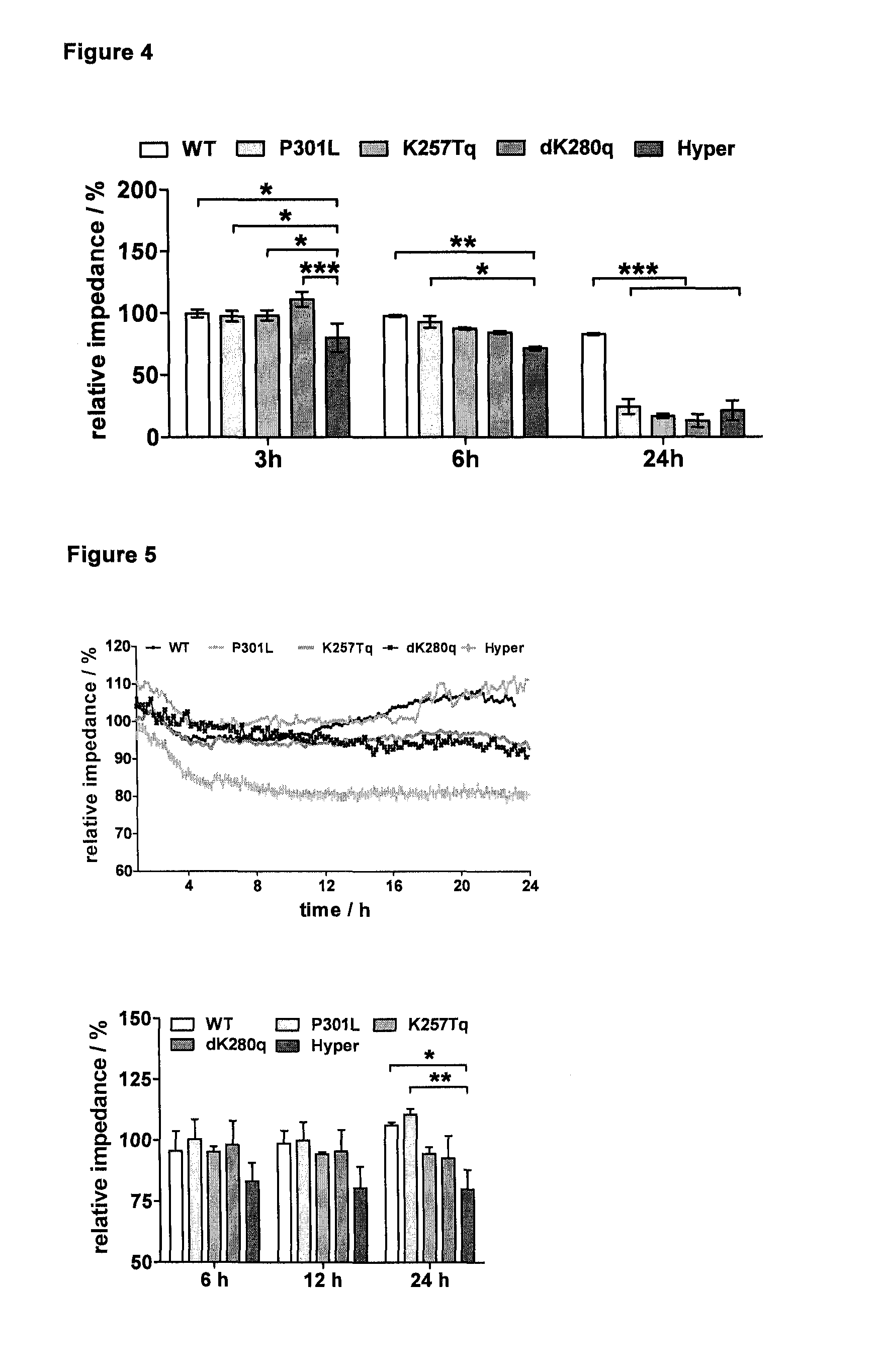Polymutant tau protein variants and their use for recapitulating human tauopathies
a human tauopathies and polymutant tau protein technology, applied in the field of polymutant tau protein variants and their use for recapitulating human tauopathies, can solve the problems of reducing the effect of oxidative stress, difficult to assess matter, and no cell culture model has been described so far that does not affect the oxidative stress of matter, etc., and achieves the effect of lowering the impedan
- Summary
- Abstract
- Description
- Claims
- Application Information
AI Technical Summary
Benefits of technology
Problems solved by technology
Method used
Image
Examples
example 1
[0122]In a first example multiple combinations of polymutant tau variants were produced and tested as transgenes in a human neuroblastoma cell line. For a better overview and comparison a single mutant tau (P301L), a 4× polymutant taUΔK280 / 9301L / V337M / R406W (dK280q) as well as the 4× polymutant taUK257T / 9301L / V337M / R406W (K257Tq) and a 5× polymutant tauK257T / ΔK280 / P301L / V337M / R406W also referred to as hyper mutant tau (Hyper) are shown. In order to assure comparable levels of tau variant transgene expression, all constructs were expressed using the same lentiviral expression system. Transgenic cell lines were rapidly generated after viral infection and selection of transduced cells that had stably integrated the tau variant transgene into their genome.
[0123]Unexpectedly, it was found that the induction of differentiation (20 nM staurosporine) lead to the formation of abnormal tau aggregates exclusively in the Hyper-tau cell line (FIG. 1, arrow) without the addition of toxic cofactor...
example 2
[0129]To demonstrate the unique performance of the Hyper-tau mutant cell line impedance spectroscopy was used as a sensitive label-free real-time monitoring technique, described in detail in Jahnke et al. 2009. In a first step the inventors used the toxic phosphatase-inhibitor okadaic acid that is widely used in AD-related in vitro assays for the hyperphosphorylation of the tau protein (FIG. 4).
[0130]Given that okadaic is commonly used for artificial induction of tau hyperphosphorylation in in vitro experiments under non-physiological conditions, the inventors were able to detect impedimetrically an initial Hyper-tau mutant specific degenerative effect after 3 and 6 hours, respectively. With increasing incubation time toxic side effects of okadaic acid leads to overall cell toxicity in all tau mutant cell lines resulting in a strong decrease of impedance.
[0131]To overcome the limitations of using artificial induction of pathology and thereby focusing to specific but not fully valida...
example 3
[0132]The unique effects of the Hyper-mutant tau could be used in a functional tau pathology in vitro screening assay for identification and efficiency quantification of potential active pharmaceutical ingredients. Taking the significant difference between the physiological condition (wildtype tau expressing cells) and the pathological condition (Hyper-tau expressing cells) that can be monitored via impedance spectroscopy, the efficiency of compounds to attenuate the pathological cellular degeneration can be quantitatively determined.
[0133]Exemplarily the inventors used two kinase inhibitors to demonstrate the capabilities of the Hyper-tau based screening assay (FIG. 6). In detail SRN-003-556, a developed lead compound with moderate specificity to ERK2, and AR-A014418, a specific GSK3R-inhibitor were tested. Both inhibitors showed a therapeutic effect within tau pathology in vitro assays that are based on artificial hyperphosphorylation using toxic compounds like okadaic acid (LeCor...
PUM
| Property | Measurement | Unit |
|---|---|---|
| time | aaaaa | aaaaa |
| time | aaaaa | aaaaa |
| alternating voltage | aaaaa | aaaaa |
Abstract
Description
Claims
Application Information
 Login to View More
Login to View More - R&D
- Intellectual Property
- Life Sciences
- Materials
- Tech Scout
- Unparalleled Data Quality
- Higher Quality Content
- 60% Fewer Hallucinations
Browse by: Latest US Patents, China's latest patents, Technical Efficacy Thesaurus, Application Domain, Technology Topic, Popular Technical Reports.
© 2025 PatSnap. All rights reserved.Legal|Privacy policy|Modern Slavery Act Transparency Statement|Sitemap|About US| Contact US: help@patsnap.com



